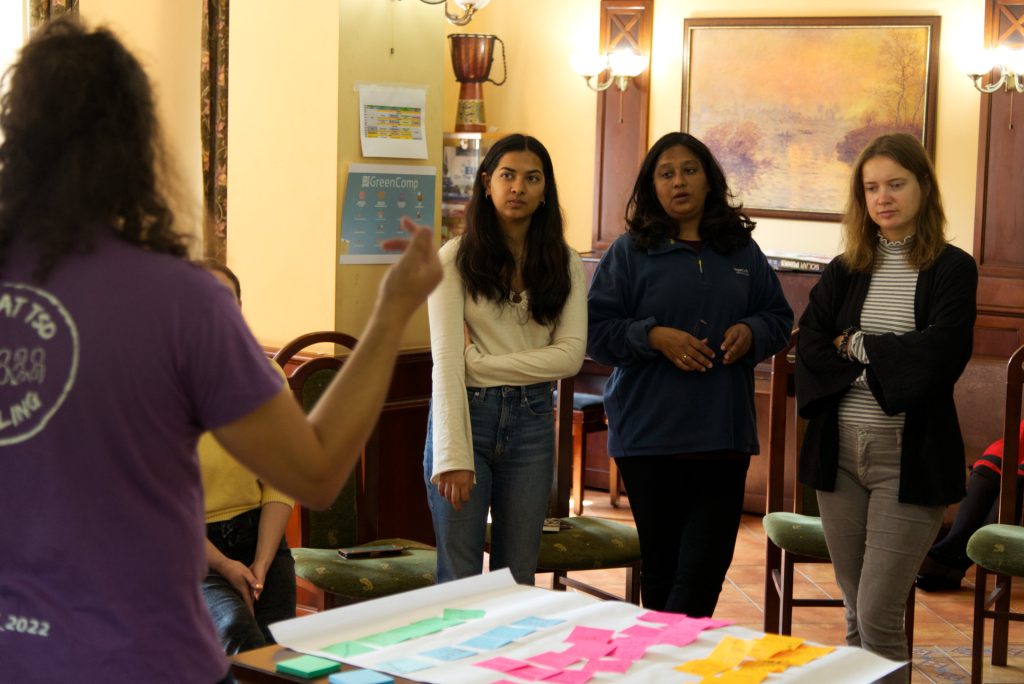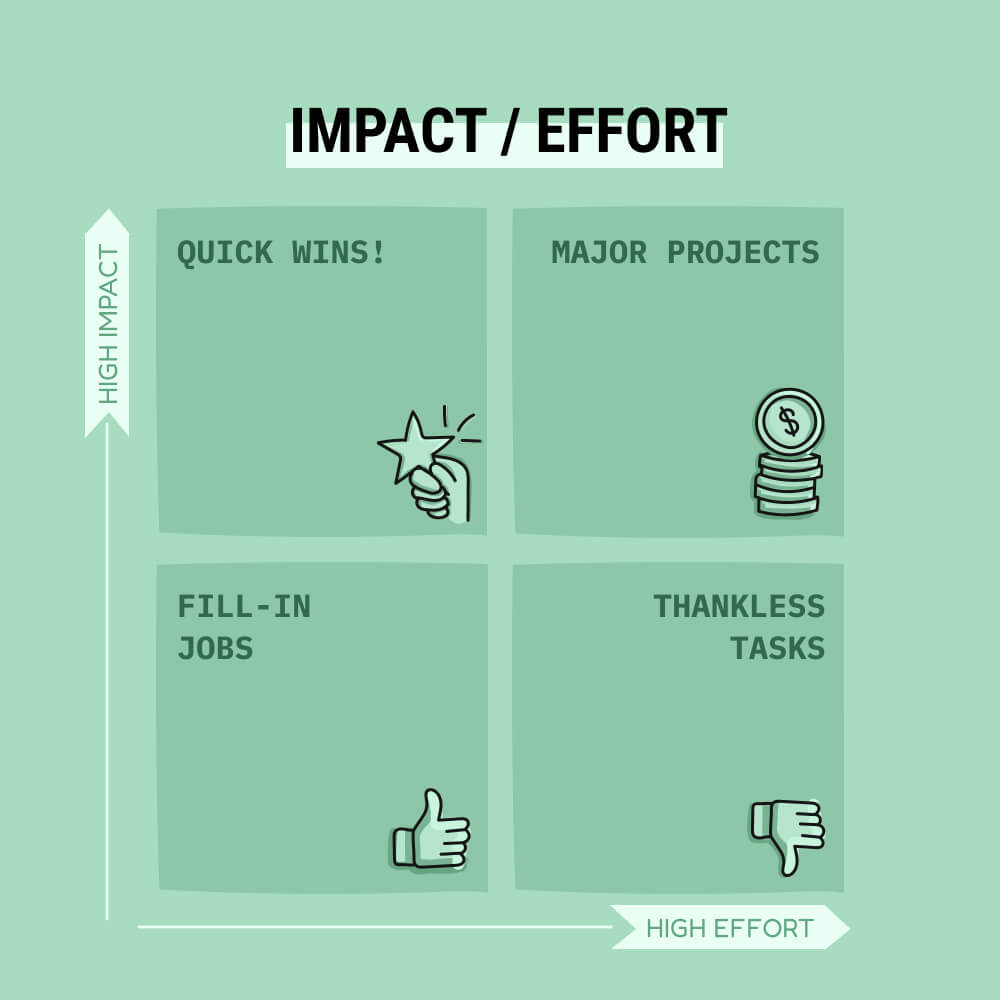So, you want to facilitate a Climate for All workshop?
It’s powerful in its simplicity!
We devised a format that is straightforward to follow, can be used with our original games or other games related to sustainability, and can deliver on our promise: your players will become aware of the competences they put to practice through play, and be ready to turn them into local climate action!
You will need 90-120 minutes in addition to the duration of the game of your choice, a copy of the game itself (feel free to download, print, and prepare one of our original games), and some basic workshop materials, like flipchart sheets, markers, and sticky notes.
Read through this page for a brief overview. This will give you a good idea of how the workshop can be facilitated. You can navigate through the different steps by clicking on each title to open the instructions for the respective step. If you are ready for a level up, we highly recommend completing our free online facilitator training course! This will get you a much deeper understanding of how to facilitate the workshop, the philosophy behind it, and why each step is designed that way, along with details to make your facilitation engaging and effective. This will also make you a certified Climate for All facilitator!

1. INTRODUCE
What is this all about and what will happen today?5-10
minutesWelcome your participants
Create a pleasant and inclusive atmosphere for your participants where everyone feels welcome as they enter the room.
Introduce the project
When everyone has arrived and the time is right, briefly introduce yourself and the project. You can use the following lines to introduce the project, freely rephrasing to your style:
“Welcome, everyone! Today, we’re not just here for a workshop—we’re here to join a movement reimagining how we tackle one of humanity’s greatest challenges.
Climate for All was born from a simple but powerful idea: What if the path to climate action was paved with joy, creativity, and play instead of fear and despair?
In a world that often feels overwhelmed by crisis, we chose a different response. We turned climate competences into games. We transformed fear into fun. We replaced isolation with community.
What makes this approach special?
Through the game we’re about to play, you’ll experience firsthand how storytelling, strategy, and shared imagination can help us not only understand our changing world but also believe in our power to change it.
No expertise required. No degrees needed: just your curiosity, your care, and your willingness to play.
From kitchen tables in Kraków to university halls in Mauritius, this same experience is unfolding in communities worldwide. You’re part of something bigger—a movement growing game by game, facilitator by facilitator, community by community.
This isn’t just another workshop. It’s an invitation to recognise a simple truth: the future belongs to those who dare to reimagine it—and invite others to play along.
Our approach has even caught the attention of the European Commission, which selected Climate for All as one of the most Inspiring Green Education projects of 2024!
Today, through play, you’ll practice essential climate competences like systems thinking, collaboration, adaptability, and political agency. And when we’re done playing, we won’t stop there. We’ll reflect together, map our spheres of influence, and identify concrete actions we can take in our own communities.
So, are you ready to play the change you wish to see in the world?
Let’s begin.”
Optionally, play a name game
You can also include a short name game at this point, if your participants don’t already know each other. But keep this entire section short and sweet, as there is no better ice-breaker than the game you are about to play!
2. PLAY
Play a Climate for All game or another game suitable for the purpose30-240
minutesPlay a game!
Play one of our original games or another suitable for developing green skills. Make sure to select a game that fits your audience type and needs.
- Find our original games on our main page
- Try some other favourite games with our workshop format
- Or browse our database with 115 suitable games (plus our own 6)
Conclude the game
Give your participants enough time to finish their game.
If it’s a game with heavy emotional involvement, make sure also to run an activity that will allow them to decompress and safely exit the state of mind associated with the gameplay. This is especially important if your game is a Live-Action Role-Play (LARP), as this type of game allows for a deep immersion into the narrative and characters your participants may play, which can result in intense feelings and a phenomenon called “bleed“. Methods for “de-roling“, often borrowed from drama therapy, are becoming increasingly popular in LARP settings and are highly recommended in our case. Our original LARPs include both safety mechanics and de-roling methods in their manuals!
3. REFLECT
What happened during the game and what did your participants learn from it?15-20
minutesHow did they feel?
Invite your participants to form a circle. Ask them how they felt while playing the game. Give them time to explore the emotions they developed through gameplay and share them in a safe environment. Any emotion felt during the game is valid and welcome.
What did they learn?
After sharing their feelings and emotions, ask your participants what they learned from playing this game. Can they mention any specific skills, knowledge, attitudes, or behaviours practised or revealed through play? Let them answer openly and without following any pre-existing structure. Again, any answer is valid and welcome. There are no right or wrong answers here, as this is their own lived experience.
What Green Competences did they tackle?
Now it’s time to use a specific framework! Our games were developed with the GreenComp framework in mind. You can study more about it on our community page before you host a Climate for All workshop. GreenComp, the European sustainability competence framework, is a conceptual tool that defines 12 competences related to sustainability.
Following the open discussion on learning points from the previous step, it’s time to see if they align with any of the competences defined by the GreenComp framework. We developed a handy tool for that purpose.
Use the 12 cards with the predefined competences (3 per category) from our deck of GreenComp cards. Get your prepared cards and spread them face up on a desk/table. Ask everyone to form a circle around the desk/table so they can all see. Ask the players to read through it, and each point out the card with the top competence they feel they tackled while playing. You can then ask them to discuss amongst themselves and point out the top three competences they all agree they practised during the game.
4. MAP
Identify stakeholders within their circles of influence20-25
minutesMap stakeholders in their local ecosystems
Ask your participants to map different types of stakeholders they can reach out to in their local ecosystem. It can be any stakeholder, from friends and family, to schools and universities, volunteer groups and NGOs, activist and culture groups, local or international companies, local, regional or national government departments, or even intergovernmental organisations.
The important thing, however, is that they identify stakeholders they can influence directly, communities where their voice is heard, and places where it will actually happen if they suggest an action.
You will need a flipchart sheet, markers, and sticky notes for this. Ask them to write down only one stakeholder per sticky note and then stick it on the flipchart sheet. Give them 10 minutes for that, and when the time is up, you will have an ecosystem of ecosystems consisting of people and communities your participants can influence!
5. BRAINSTORM
Come up with actions to take20-25
minutesCompetence + Stakeholder = Action
After realising the green competences they practised through play and mapping stakeholders they can influence in their local ecosystems, it’s time to combine the two! Ask your participants to brainstorm on climate actions they can take if they match a specific competence with a specific stakeholder within their circle of influence.
All you need for this are sticky notes and markers. Once again, ask your participants to write only one action per sticky note, as we will move them around afterwards. Give them 10 minutes to brainstorm at least three actions each. Ask them to define the actions concisely, but be as specific as possible. If they can answer “who”, “what”, “when”, “where” for that action, despite the small size of a sticky note, then you’re on a great path.
It’s important to create a judgment-free zone where all ideas can flourish. Respond to contributions with ‘Yes, and…’ rather than ‘No, but…’ This approach builds on creativity rather than shutting it down. Remember: quantity breeds quality—the best ideas often emerge from a foundation of many.
6. ACT
Prioritise and plan the first action30-40
minutesPrioritise using the impact/effort matrix
You should now have an abundance of ideas lying around on sticky notes. It’s time to place them all on a large flipchart sheet that can help prioritise which actions to pursue first! We will do this using the impact/effort matrix.
On a flipchart sheet, draw two axes.
- The Y axis represents the potential impact of the actions. That’s the effect the actions will have on the environment and society, and the higher you go, the more profound the impact, the broader its scale, the longer its effect, and so on.
- The X axis represents the effort required to make it happen. That could be the number of people, resources, money, complexity, and everything else needed to implement that action.

Ask your participants clarification questions to define an action’s level of impact or effort to help them move the associated sticky note along the matrix accordingly. All ideas are welcome and valuable; exploring a complete working plan for each action is unnecessary. Your aim here is to crystallise whether a specific action would have a high or low impact and require a high or low effort so that it can be placed on the matrix.
Using the matrix will help your participants decide which action to pursue. This decision is theirs alone!
Mark your calendars!
The final step of the workshop is to motivate your participants to take the action they just decided should be their priority. You can achieve this with a straightforward, almost mischievous plan:
- Ask them to visualise the teeniest tiniest task they can do first for the action they decided to take
- Ask them to pick up their mobile phones
- Open the calendar app
- Create a reminder for when they will take this first task within the next couple of weeks!
- As a bonus, you can also introduce a buddy system. Pair your participants up in pairs they feel comfortable with and ask them to add each other to the events they just created so they can check in on each other when the time comes.
That’s it! Your Climate for All workshop is over! You can now celebrate with your group however you prefer, as long as everyone can participate.
Join a global community of action
Now that your workshop is over and your participants have their climate actions planned, they (and you) can also join the Climate for All community and inspire a global community with their climate actions!
Looking for a Level Up?
Why not get certified? Our method remains simple, but completing our full course will greatly enhance your facilitation skills! Go ahead, you know you want to…
